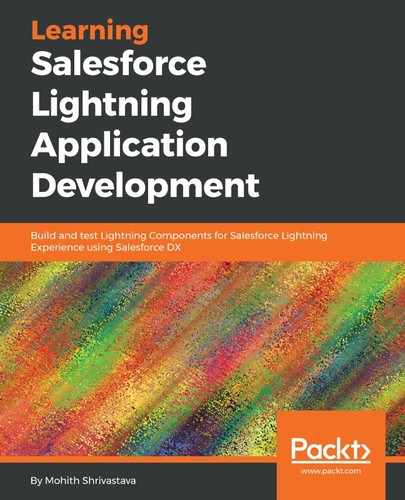This chapter focused on how you can package your Lightning Components and other assets, and the steps required to publish on Salesforce AppExchange. This also brings us to the end of this book. This book covers the basics, so you can start building your Lightning Components using Salesforce DX and Lightning design systems to solve your business needs with custom Lightning Components. This book also extensively covered Salesforce DX and how it can accelerate development on the Salesforce platform. Lightning Component, along with Salesforce DX, is the future of Salesforce application development. If you are building enterprise applications, I would also recommend you build some design patterns around the framework or use open source projects, such as LAX (https://github.com/ruslan-kurchenko/sfdc-lax). In the coming years, it will be interesting to see how Salesforce further improves the component framework, as JavaScript and web components evolve, and the capabilities that it adds to the Salesforce DX and its packaging ability. Keep an eye on the Salesforce release notes with every release to find enhancements and improvements. Salesforce also offers Trailhead as a learning tool. I strongly recommend readers leverage trailhead.Salesforce.com to get hands-on experience with projects and modules for free on Trailhead.
- Title Page
- Copyright and Credits
- PacktPub.com
- Foreword
- Contributors
- Preface
- Introduction to the Lightning Component Framework
- Lightning Experience
- Lightning Component architecture
- Setting up a Salesforce developer organization to enable the building of Lightning Components
- The Lightning Design system
- Summary
- Exploring Salesforce DX
- Enabling the developer hub in your Salesforce organization
- Installing the Salesforce DX CLI
- Salesforce DX commands
- Lightning commands
- Metadata API commands
- Data import and export commands in Salesforce DX
- Installing the Visual Studio extension pack for DX
- Summary
- Lightning Component Building Blocks
- Component markup and using Lightning base components for layouts
- Component definition aura:component
- Lightning base components for layout and layout items
- Lightning card base component
- Example layouts using the Lightning layout and card components
- Horizontal alignment using the Lightning layout base component
- Vertical alignment using the Lightning layout base component 
- Stretching a LayoutItem using the flexibility attribute
- Creating multiple rows and controlling the size of the row in Lightning layout
- Lightning layout to handle multiple devices
- Nested page layout using Lightning Layouts
- Understanding attributes
- Using Expression syntax
- JavaScript controller and helper
- Wiring the client-side to the server using Apex controllers
- Summary
- Component markup and using Lightning base components for layouts
- The Lightning JavaScript API
- Technical requirements
- Using component get and set methods
- Using the find function to locate the DOM
- Introducing Locker Service
- APIs available in $A top-level functions
- Format date/DateTime using the Aura Localization Service
- Dynamically creating components using $A.createComponent()
- Modifying the DOM in the RENDERER JavaScript file of the component bundle
- Using custom labels in Lightning Components
- ES6 support in Lightning Components
- Summary
- Events in the Lightning Component Framework
- Lightning Data Service and Base Components
- Lightning Data Service
- Example components using Lightning Data Service
- Lightning base components
- An introduction to Lightning input field components
- Creating a contact edit form using the Lightning input field and RecordEditForm components
- Using the Lightning output field component
- The list view component 
- Creating a tree view using the tree and tree grid components
- Formatting output data using Lightning base components
- Using the datatable component
- Using Lightning input components
- Using the carousel component
- Summary
- Using External JavaScript Libraries in Lightning Components
- Third-party JavaScript libraries in Lightning Components
- Attributes
- Events
- Integrating a third-party library into Lightning Components
- Integrating the Select2 JavaScript library into Lightning Components
- Integrating the MomentJs library into Lightning Components
- Creating a Locker Service-compliant JavaScript bundle using webpack
- ChartJs in Lightning Components
- Making client-side calls to external sites using JavaScript
- Communication between the Lightning main frame and iframe
- Rendering a React application in a Lightning Component using Lightning:container
- Summary
- Third-party JavaScript libraries in Lightning Components
- Debugging Lightning Components
- Performance Tuning Your Lightning Component
- Storable actions
- Avoiding nested aura:if in aura:iteration
- Events strategy for performance and ease of code maintenance
- Optimizing JavaScript in Lightning Components
- Unbound expression bindings
- Using the Lightning data service
- Leveraging Lightning base components
- Optimizing Apex code
- Disabling Debug Mode for production
- Summary
- Taking Lightning Components out of Salesforce Using Lightning Out
- Lightning Flows
- Making Components Available for Salesforce Mobile and Communities
- Lightning Navigation and Lightning Console APIs
- Unit Testing Lightning Components
- Publishing Lightning Components on AppExchange
- Namespacing Salesforce developer instances for managed package generation
- The impact of namespacing Salesforce instances on the component bundle
- Creating scratch Orgs with namespaces
- Creating a managed package
- Documenting your components using the auradoc file
- Using the design file to allow admins to configure attributes
- Publishing components on AppExchange
- Summary
- Other Books You May Enjoy
Summary
-
No Comment
..................Content has been hidden....................
You can't read the all page of ebook, please click here login for view all page.
